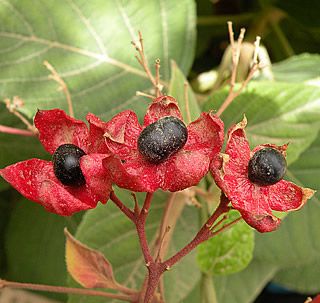The Hill Glory Bower (Clerodendrum infortunatum) is a flowering, semi-herbaceous, and gregarious shrub, which naturally forms groups around the parent plant. It is native to moist woodlands and along rivers in tropical areas up to 1,640 feet (500 meters) above sea level in various parts of Asia. It is now widely spread, being cultivated in many tropical and subtropical areas of the world. In many places, it is mistakenly identified as Clerodendrum fragrans, synonymous with the Chinese Glory Bower (Clerodendrum chinense). However, although they belong to the same genus, these shrubs differ mainly in floral morphology.

The Hill Glory Bower features erect, quadrangular branches covered with a dense, short layer of yellow hairs. The leaves are opposite, large, ovate with a cordate base, long petiolate, with irregularly serrated margins, and pubescence on both surfaces. They release a fetid aroma when injured.
It blooms in winter, while most plants are dormant, displaying inflorescences of the type panicle of pedunculated cymes, terminal and erect, above the foliage. The flowers are hermaphroditic, white tinged with pink, pentamerous, with long stamens and protected by light green bracts. They have a delightful perfume and are very attractive to bees and butterflies. At dusk and at night, the aroma of the flowers becomes even more intense. The subsequent fruit is a drupe type, bluish in color.

This Hill Glory Bower is generally chosen and preferred for the perfume of its flowers and the dense, full effect of its foliage. It can be used alone or in groups, but it should always be considered that it continuously multiplies from the roots, forming extensive clumps if not controlled.
Thus, depending on the location, it is interesting to contain the shrub in pots and gardeners, or in corners of the garden. It should also be avoided in areas of passage or windy places, as the leaves release an unpleasant odor when handled. It is ideal for the edges of woodlands and along walls, especially in gardens that can be enjoyed at night, while the fragrance of the flowers is more enticing.
In India, the Hill Glory Bower is considered a medicinal plant and widely used in traditional Ayurveda and Siddha medicine. It contains compounds such as Clerodolone, Clerodone, Clerodol, and a steroid named Clerosterol, among other constituents like flavonoids and saponins.
It should be grown in full sun or partial shade, in fertile, deep soil, enriched with organic matter, and irrigated regularly. It does not tolerate frost or intense cold. It suffers during dry periods and is capable of tolerating waterlogging, so it is advisable to keep the plant in a substrate kept moist. Propagation is by cutting of the branches and separation of the shoots formed around the original plant.

